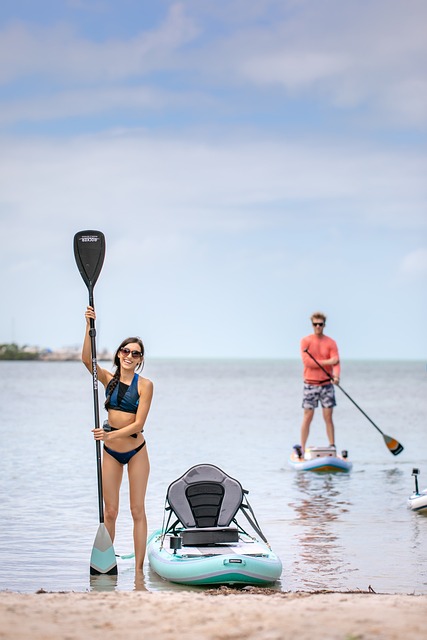Choosing a best inflatable paddle board (IPB) with a robust non-slip deck surface is paramount for safety and enjoyment in outdoor activities. These surfaces combat slippery conditions caused by sunlight, weather, and paddling motion, enhancing stability and control for paddlers of all skill levels. Specialized coatings or adhesives offer superior grip, while strategically placed mats or tapes provide added stability for beginners. Regular maintenance, including cleaning, reapplication, and inspection, ensures the non-slip surface endures, enhancing safety and extending the lifespan of the IPB. This game-changing technology has made water sports more accessible and enjoyable for a diverse audience.
In today’s active lifestyle, choosing the right surface for water activities is paramount, especially for the popular inflatable paddle board (IPB). A non-slip deck surface enhances safety and performance, transforming your IPB from a simple float into a dynamic tool. This article explores the significance of non-slip surfaces, benefits tailored to IPB users, essential features in materials, top solutions for optimal performance, installation tips, and real-world applications that elevate the user experience, ensuring you get the best out of your inflatable paddle board.
Understanding the Importance of Non-Slip Surfaces

In the quest for a safe and enjoyable outdoor experience, especially with popular activities like stand-up paddling gaining traction, understanding non-slip surfaces becomes paramount. When it comes to water sports, choosing the right equipment can make all the difference. For instance, when considering the best inflatable paddle board, a non-slip deck surface is not just a feature—it’s a necessity. These surfaces offer enhanced safety by preventing accidents, particularly in wet or slippery conditions, ensuring paddlers of all skill levels can focus on enjoying their time on the water rather than worrying about stumbles and falls.
Non-slip technology plays a crucial role in providing traction for users, reducing the risk of injuries associated with slipping. This is especially important when considering that various elements like sunlight, weather conditions, or even the natural motion of paddling can cause deck surfaces to become slick. By selecting gear with robust non-slip properties, individuals can confidently face these challenges, allowing them to fully immerse themselves in activities like stand-up paddle boarding without compromise.
The Benefits of a Non-Slip Deck for Inflatable Paddle Boards

Non-slip deck surfaces are a game-changer for inflatable paddle boards (IPBs), enhancing safety and performance in various water conditions. For enthusiasts who frequently use their IPBs on lakes, rivers, or even in the ocean, having a non-slip coating is essential. This feature significantly reduces the risk of slipping or losing balance, which can be particularly crucial when navigating choppy waters or performing tricks.
A best inflatable paddle board equipped with a non-slip deck provides better control and stability, making it easier for users to maintain their pace and direction. This benefit is especially valuable for beginners learning to paddle or experienced riders trying out more advanced maneuvers. The textured surface ensures that the rider’s feet stay firmly in place, allowing them to focus on enjoying the water and improving their paddling skills without worrying about slipping.
Key Features to Look For in Non-Slip Deck Materials

When choosing non-slip deck materials for your best inflatable paddle board, several key features should be at the top of your list. Firstly, look for surfaces that offer superior traction. This ensures a secure stand and prevents accidents during use, especially in wet or slippery conditions. Textured patterns or specialized coatings are common methods to achieve this.
Additionally, durability is paramount. Deck materials must withstand regular exposure to water, UV rays, and pressure from paddling. Opting for high-quality, resistant materials will prolong the board’s lifespan. Consider options that are scratch-resistant and can maintain their non-slip properties over time, ensuring consistent performance for your paddling adventures.
Top Non-Slip Solutions for Best Inflatable Paddle Board Performance

When it comes to choosing a non-slip deck surface for your best inflatable paddle board, there are several top solutions that can enhance performance and safety. One effective option is to opt for specialized non-slip coatings or adhesives designed specifically for water sports equipment. These products offer superior grip, ensuring you stay put during intense paddling sessions. Look for those with a textured finish, which provides added stability without compromising the board’s flexibility.
Additionally, consider incorporating non-slip mats or tapes into your setup. These simple yet effective accessories can be strategically placed to create key areas of traction. For instance, positioning them near the standing area and at the grip points can significantly reduce the risk of slipping during turns or when stepping off the board. This is especially beneficial for beginners or those seeking a more secure experience on their best inflatable paddle board.
Installation and Maintenance Tips for Non-Slip Decks

When installing a non-slip deck surface, whether for a swimming pool or even a best inflatable paddle board setup, ensuring proper preparation is key. Start by cleaning and preparing the existing deck to create a smooth base. Apply the non-slip coating evenly, following the manufacturer’s instructions for optimal adhesion. Regular maintenance involves reapplying the coating every few years or as recommended by the product, especially in high-traffic areas like pool decks.
To keep your non-slip deck in top condition, regularly inspect it for any signs of wear and tear. Remove debris and loose particles to prevent surface damage. For best results with a paddle board or similar watercraft, consider using a slightly different coating designed for these applications, as it may endure more friction and potential abrasions. Regular maintenance not only enhances safety but also extends the lifespan of your non-slip surface, ensuring a steady and secure experience for all users, whether they’re enjoying a swim or paddling on their board.
Real-World Applications: How Non-Slip Surfaces Enhance User Experience

Non-slip deck surfaces have revolutionized various industries, from maritime to recreational activities. In the context of water sports enthusiasts, particularly those who enjoy paddle boarding, a non-slip surface on inflatable paddle boards (IPBs) is a game-changer. The best IPB designs prioritize user safety and comfort by integrating anti-skid technology into their decks, ensuring stable and secure footing during paddling. This feature is especially beneficial in dynamic conditions like rough waters or varying weather, where slip and fall accidents can occur.
By reducing the risk of injuries caused by slipping, non-slip surfaces enhance the overall user experience. They enable paddlers to focus on enjoying the outdoors, improving their balance, and appreciating the surroundings without worrying about instability. This innovation has not only increased safety but also encouraged more people to engage in water sports, making it accessible to a wider audience, including those with various skill levels and physical abilities.
